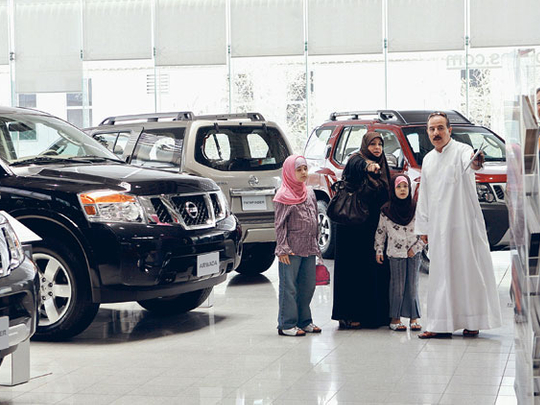
Dubai: When comparing incentives that are offered when buying a new car, it’s important to consider the financial factors and do the math beforehand, in order to make the right decision that is most cost-effective for you.
A buyer looking to purchase a new car is often bombarded by adverts promising big savings. The most common of these car-buying incentives are in the form of discounts, cash rebates or cashback offers, and a lower interest rate applied to your car loans.
With cash rebate or cashback offers, the car manufacturer gives you a one-time rebate usually deducted from your car’s purchase price, after you pay the entire amount. Rebate amounts vary, but they usually range from Dh1,000 to Dh3,000.
When you are offered a lower interest rate, what this means is that the dealer offers an interest rate on a loan that is lower than the normal rates offered.
Only one deal per purchase
Car manufacturers usually allow only one deal per purchase. Sometimes you get to choose which offer to take. But keep in mind when evaluating the low interest rate offer that only those with a strong credit history qualify for the lowest published rates.
Consider the specifics to see whether the lower interest rate or the cash rebate/cashbacks is the better option for you. Following is an example to help understand.
At a car dealership, cashback also implies a rebate offered by the manufacturer of the car you are looking to buy. This cashback rebate is not provided by the dealership you are shopping with. However, manufacturers do authorise dealerships to advertise these rebates.
Calculate your payments
Say you buy a Dh47,000 car and put no money down. The dealership offers a 60-month loan with one option being a cash rebate or cashback offer, with the second option being a zero per cent interest rate.
With zero per cent financing, even though you don’t pay interest on the loan, you end up with a higher monthly payment, and you pay about Dh650 more over the life of the loan because you borrow more money.
Consider all the variables
If your goal is to end up with the lowest monthly payment, the cash rebate or cashback offers are typically the better alternative.
However, variables such as how much money you put down, the total purchase price of the vehicle, any trade-in values and the length of the loan can affect the total you pay. A longer loan term can lower your monthly payment, but you pay more total interest over the life of the loan.
How car loans work?
A lower monthly payment on your car loan doesn’t always mean you’re saving money. So, it’s vital one understands how car loans work.
When you take out a car loan from a financial institution, you receive your money in a lump sum, then pay it back (plus interest) over time. How much you borrow, how much time you take to pay it back and your interest rate all affect the size of your monthly payment.
The major factors that affect both your monthly payment and the total amount you’ll pay on your loan includes; the loan amount, which can be significantly less than the value of the car, depending on whether you have a trade-in vehicle and/or making a down payment.
The second factor includes the annual percentage rate. Usually referred to as the APR, this is the effective interest rate you pay on your loan. The third factor is the loan term, which is the amount of time you have to pay back the loan, typically 36-72 months.
How do these factors affect your monthly payment?
A lower monthly payment always sounds good, but it’s important to look at the bigger financial picture: That lower payment could also mean you’re paying more for your car over the life of the loan. Let's see how adjusting each of the three factors can affect your monthly payment:
A lower loan amount: Let's say you’re considering a Dh25,000 car loan, but you make a Dh2,000 down payment or negotiate the price of the car down by Dh2,000. Your loan amount becomes Dh23,000, which saves you Dh44.27 per month (assuming a 3.00 per cent APR and a four-year term).
A lower APR: Consider that same Dh25,000 car loan and let’s assume a 4-year term. Let’s further say that one financial institution offers a 3 per cent APR and another offers a 2per cent APR. Taking the lower APR will save you Dh10.98 per month.
A longer loan term: Extending a Dh25,000 loan from 4 years to 5 years (assuming a 3.00 per cent APR) lowers your monthly payment by Dh104.14, but, you’ll end up paying Dh391.85 more in interest charges over the life of the loan.

How a lower monthly payment can cost you more
One of the most important things to understand about how auto loans work is the relationship between the loan term and the interest you pay. A longer loan term can dramatically lower your monthly payment, but it also means you pay more in interest.
Consider a Dh25,000 car loan at a 3 per cent APR and a 48-month term. Over 4 years of payments, you will pay Dh1,561 in total interest on the loan. If you extend that same loan to a 60-month term (or 5 years), you’ll lower your monthly payment by Dh104 – but you’ll increase the total interest you'll pay from Dh1,561 to Dh1,953.
There isn’t any one-size-fits-all way to determine the best car loan. That’s why you need to take the time to understand how auto loans work and make the right decision for your specific financial situation.
Some people will benefit most by taking a longer term to reduce monthly payments and using the difference to pay down higher-interest debt. Others will prefer to make a higher monthly payment and pay off the loan sooner. And if you have an existing car loan, you may be able to save by refinancing.
What if you are offered a discount?
If you are offered a flat discount, which is essentially writing off a percentage of the total new car value (Dh47,000 in the above scenario), it becomes a much-preferred option as the monthly payment reduces considerably – the higher the discount.
In the UAE, in several instances a 10 per cent discount can be easily availed, while in some cases it can go up to 15-20 per cent at least. Other car-buying incentives include a five-year warranty and free servicing for driving 10,000km to 40,000km, or a two-year ownership period, which is the standard.
Experts view that if you don't manage to get a discount then try to get a free extended warranty or service contract or free tinting/insurance or a combination of all three. As it's a buyers’ market right now so you have some leverage, so try a different outlet/sales person to see who can give you the best deal.
Vehicle loan consultants suggest to their clients that more offers are made between the last week or closer to the end of the month, so the chances of getting a favourable one is higher considering monthly sales targets need to be achieved or maintained.
Also, as the mid-year approaches, manufacturers start importing next-year’s models, and by the month of September people often start asking for the new 2022 models. The consultants add that is when the 2021 models get significantly cheaper.
It is a financial incentive offered by one party to give a boost to the overall business. This benefit is usually passed on to the customer who is able to source a loan at a rate lower than the market rate. In retail loans, subventions are very common in the car loan segment.
Subventions vary from one car model to another and one dealer to another. Ideally, a borrower should fix the car model, know the price and fix the loan amount.
Beneficial market trends
Based on industry estimates, ex-showroom prices of popular models have seen a 5-15 per cent dip from a year ago, as dealerships try to win buyers in the most difficult market environment since 2009.
Research shows that currently there’s a steady trickle of renewed demand in new car buyers, since late last year – a tangible bounce-back after the same time last year saw demand plummet.
After what all the dealerships experienced in the April to June phase, industry experts eye this as much needed stability. No one will be holding 2019 model year vehicles in their inventory – unlike in 2009 when all of the dealerships carried unsold stocks.
A key takeaway is that among the different types of incentives explained above, matter experts add that one should seek discounts, and prefer that over the other incentives – as that option is evidently comparatively more financially beneficial or cost-effective.






_resources1_16a30b358e0_small.jpg)

